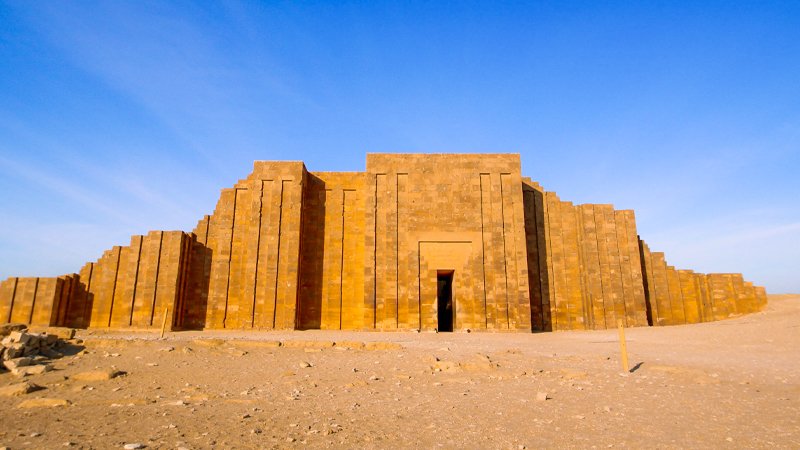Step into the enchanting world of ancient Egypt as we embark on a captivating journey through time to discover the Pyramid of Djoser, a monumental masterpiece nestled in the Saqqara necropolis. This awe-inspiring structure, also known as the Step Pyramid, is a testament to the brilliance of ancient Egyptian architects and engineers. Join us as we unravel the remarkable history, innovative construction techniques, and profound cultural significance of the Pyramid of Djoser.
Don’t forget to read our related blogs:
Pyramid of Djoser: An Architectural Marvel

The Pyramid of Djoser, located in Saqqara near the ancient capital of Memphis, is a remarkable Egyptian pyramid constructed during the Third Dynasty of the Old Kingdom, around 2630 BCE. This architectural marvel was designed by the renowned architect Imhotep and served as the eternal resting place for Pharaoh Djoser, the second ruler of the Third Dynasty. Let’s delve into the details of this extraordinary structure.
Architectural Brilliance Unveiled
Djoser’s pyramid breaks away from the conventional pyramid design found in later structures. Instead of the smooth, sloping sides we commonly associate with pyramids, Djoser’s pyramid boasts a distinctive step-like construction, comprising six distinct mastabas stacked on top of one another. This unique design, with a base measuring approximately 125 meters on each side and a height of around 60 meters, laid the foundation for the evolution of pyramid architecture in ancient Egypt.
The Burial Complex: A Royal Tribute
The Pyramid of Djoser is just one component of a grand funerary complex dedicated to Pharaoh Djoser. This complex features a sprawling courtyard, smaller tombs, a mortuary temple, and an offering chapel. The grand entrance to the complex is marked by the ceremonial “South Tomb.” It served as a place of worship and offerings, perpetuating the legacy of the eternal pharaoh.
Innovative Construction Techniques
The construction of the Pyramid of Djoser was a remarkable feat of ancient ingenuity. Local limestone blocks, expertly cut and assembled, formed the foundation of the stepped pyramid. Imhotep’s mastery ensured precise alignment at the pyramid’s corners, showcasing the ancient Egyptians’ deep understanding of astronomy and geometry.
Tura limestone was used as a facing material to enhance the structure’s stability and aesthetics. This high-quality stone lent the pyramid a polished exterior, imparting a sense of grandeur and imposing beauty. The meticulous planning and attention to detail showcased in its construction continue to captivate the world, making the Pyramid of Djoser an enduring architectural wonder.
A Beacon of Egyptian Culture
Beyond its architectural significance, the Pyramid of Djoser holds immense cultural importance for ancient Egyptians. It symbolizes their belief in the afterlife and the concept of eternity. According to their ideas, the pyramid served as a conduit to aid the pharaoh’s soul in ascending to the heavens and uniting with the gods.
Furthermore, the pyramid complex was the epicenter of religious rituals and festivals dedicated to honoring Pharaoh Djoser and ensuring his seamless journey into the afterlife. It became a pilgrimage site where generations paid their respects and offered tributes to their revered pharaoh.
Unveiling the Mystery: Pyramid Complex Excavations

Several archaeological missions have recently undertaken extensive excavations at the Djoser complex. These excavations have unearthed invaluable insights into the lives of ancient Egyptians, their funerary practices, and the advanced engineering techniques employed during pyramid construction.
Among the notable discoveries are artifacts, inscriptions, and offerings within the burial chambers and surrounding structures. These findings shed light on the rituals and ceremonies associated with the pharaoh’s burial, providing a glimpse into the religious beliefs that shaped ancient Egyptian culture.
Pyramid of Djoser’s Legacy: Shaping Pyramid Architecture
The Pyramid of Djoser’s unique design and engineering excellence laid the foundation for constructing subsequent pyramids in ancient Egypt. Its architect, Imhotep, ascended to divine status in later periods, cementing his place in Egyptian history. Many future pharaohs sought to emulate Djoser’s pyramid, adding their innovations to create awe-inspiring monuments.
Frequently Asked Questions
Is the Pyramid of Djoser the oldest pyramid in Egypt?
No, the Pyramid of Djoser is not the oldest in Egypt. The honor goes to its predecessor, the Pyramid of Meidum, dating back to the Third Dynasty.
How long did it take to construct the Pyramid of Djoser?
The exact construction duration remains uncertain, but it likely spanned several years, possibly over a decade, given the project’s scale and complexity.
Who was Imhotep, and why was he significant?
Imhotep, the chief architect and vizier of Pharaoh Djoser is credited with designing the Pyramid of Djoser. He is one of history’s earliest-known master architects, revered for his contributions to ancient Egyptian architecture and medicine.
Can visitors enter the Pyramid of Djoser?
Visitors cannot enter the Djoser pyramid due to conservation and safety reasons. However, the surrounding complex is open to tourists, allowing them to admire the majestic pyramid from the outside.
Is the Pyramid of Djoser at risk of damage or deterioration?
Like many ancient structures, the Pyramid of Djoser faces potential risks from environmental factors, tourism, and the passage of time. Ongoing conservation efforts aim to preserve this invaluable heritage.
What other attractions are near the Pyramid of Djoser?
Several other historical attractions near the Djoser complex include the Pyramid of Unas, the Serapeum, and the Mastaba of Ti, allowing visitors to explore more of Egypt’s fascinating history.
Conclusion: Preserving Ancient Marvels
The Pyramid of Djoser is a testament to the brilliance and ingenuity of ancient Egyptian civilization. Its unique step-like structure and cultural significance make it a captivating destination for history enthusiasts and tourists worldwide. As we continue unveiling its mysteries through ongoing archaeological endeavors, let us remain committed to preserving this ancient marvel for future generations to behold and appreciate.


